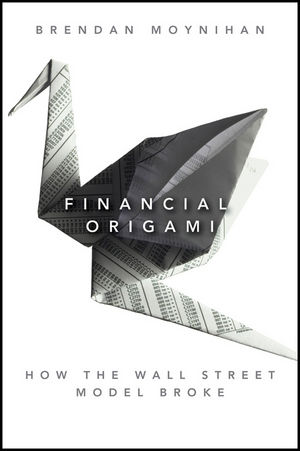Financial Origami: How the Wall Street Model BrokeISBN: 978-1-118-00181-3
Hardcover
192 pages
April 2011
 |
||||||
Connect with Wiley Publicity
Origami, the Japanese art of folding paper into beautiful shapes, is the perfect metaphor for the financial engineering that Wall Street has engaged in for years. Instead of folding paper, Wall Street’s quants and rocket scientists fold the attributes of Wall Street’s stocks, bonds or derivatives into new securities in order to allocate risk, reduce financing costs, and create free-flowing capital. It’s now clear that this type of financial origami was a major factor in the credit crisis and financial meltdown of 2008-2009.
In his new book, Financial Origami; How the Wall Street Model Broke (Wiley/Bloomberg Press; Hardcover; April 2011; $27.95; 978-1-118-00181-3) Brendan Moynihan, editor-at-large for Bloomberg News and a twenty-year market veteran, describes how the Wall Street business model has evolved from a method to transfer risk into a method for manufacturing risk. Page by page, he skillfully dissects financial engineering and addresses how financial origami, along with its inherent conflicts of interest, have allowed individuals as well as institutions to skirt regulations or taxes, sometimes meet investor needs, and always boost their profits.
Financial Origami explains how in the comparatively stable years of the early 2000s, when there was less risk to transfer, Wall Street began manufacturing risk by creating products that multiplied risk exposures and encouraged subprime lending. With the collapse of Lehman Brothers the model effectively died. Moynihan explains how the recent model of financial origami essentially became a process of taking the attributes of a few, basic pieces of paper, such as stocks, bonds and insurance contracts, and folding and refolding them to form something that seems new. Over time, Wall Street’s penchant for financial origami ceased to be a benefit to the economy and became detrimental to overall financial and economic stability.
The broken model of folding existing products into "new" ones is not the only financial engineering performed in the world of finance. Financial Origami also touches on additional instances such as:
- Industry refolding in the form of firms, once specializing in specific tasks within the risk-transfer business, now seeking to offer one-stop shopping for all financial services
- Firms refolding their business charters from private partnerships to publicly traded, shareholder owned corporations
- Altering the mortgage lending process by unfolding the mortgage market: unbundling the origination, funding, and servicing components so they could be carried out by separate companies
- How Wall Street began manufacturing risk by creating products that multiplied risk exposures and encouraged subprime lending
While the credit crisis put a spotlight on financial innovation, the rapid growth of the over-the-counter derivatives market and engineered products has been a simmering controversy since the 1980s. Moynihan explains the events that have shaped financial markets, firms, and products over the past forty years, and has hurt Wall Street over the past three. It also explores the evolution of Wall Street, shows the logical sequence of events that caused the financial crisis of 2007-2009 and shares insight on how to fix some of Wall Street’s problems.



